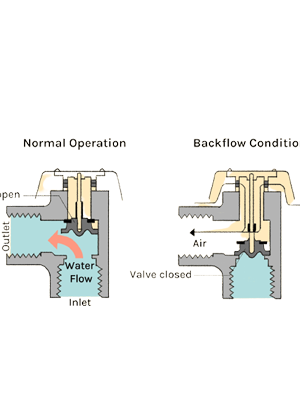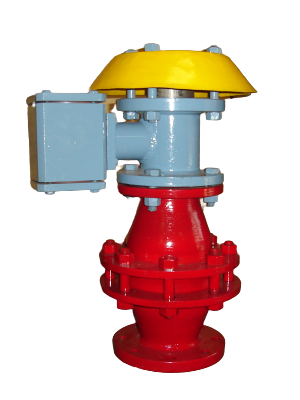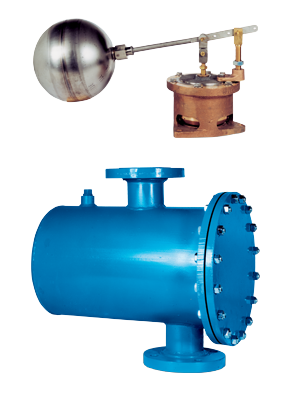Pressures cum Vacuum Relief Valve
These are useful as relief valves for blanketed vessels in which solvents
are filled & drawn out at a high flow rate. These can also be fitted, on
the process vessels to safeguard the process equipment where
unpredicted fluctuations in pressure may occur. By retaining toxic
vapours and avoiding atmospheric contamination these help to provide
increased fire protection and safety. Pressure cum vacuum relief /
breather valves are designed to protect your tanks from possible
casualty due to over pressure created by thermal expansion & product
movement into the tank and excessive vacuum created by thermal
contraction & product movement out of the tank. At the same time, it
minimises costly product evaporation / loss. Continued design
improvements provide these valves with high efficiency, maximum
flow capacity and minimum leakage. These are available "closed end
hoods" type of standard design or with "pipe-away design" for vapour
recovery. These can also be offered as only the vacuum relief valves
with blind flange on pressure port and vice-versa


Breather Valve
Breather Valves, also known as direct acting Pressure/Vacuum Relief
Valves, are special types of Relief Valves which are specifically
designed for tank protection. The range includes pressure only,
vacuum only and combined Pressure/Vacuum Valves, all available with
flanged outlets or vented to atmosphere.
Pressure/Vacuum Relief Valves are used extensively on bulk storage
tanks, including fixed roof tanks with floating covers, to minimise
evaporation loss. The Valves prevent the build-up of excessive pressure
or vacuum which can unbalance the system or damage the storage
vessel.
Pressure and vacuum protection levels are controlled with weighted
pallets or springs and can be combined to provide the required
Pressure/Vacuum settings. It is common to combine pallet and spring
systems in one unit i.e., pressure settings require a spring section,
whilst the vacuum settings use the pallet method.
API Standards are provided as an engineering aid for specification and
selection of "normal" and "emergency" pressure and vacuum Relief
Valves for aboveground liquid petroleum storage tanks. Normal venting
capacity is obtained without exceeding pressure or vacuum that would
cause physical damage or permanent deformation to the tank. The
following will help in sizing a Pressure/Vacuum Valve.
- Normal Relief. The sum of vapor replacement resulting from
emptying or filling and thermal in-breathing or outbreathing.
- Emergency Relief. Thermal out-breathing from fire exposure.
- All Tanks. Generally, require the sizing of a normal pressure and
vacuum Relief Valve to be sized and an independent emergency
Relief Valve to be sized separately.
- Flow Curves. These curves provide pressure and vacuum capacity
which is required for sizing.
OSHA suggest sizing should be in accordance with API 2000. All
requirements are clearly defined in this publication.
Vacuum Relief Valve
Vacuum relief valves are used in water heater/tank applications to
automatically allow air to enter into the piping system to prevent
vacuum conditions that could siphon the water from the system and
damage water heater/tank equipment. These valves are suitable for
low pressure steam and water service, and are ideal for use in water
heaters and supply tanks, table top heaters, jacketed steam kettles,
unit heaters, low pressure steam systems, and steam coil heaters.


Vacuum Breaker
When a boiler is taken off-line, the steam in the steam space
condenses and leaves a vacuum. This vacuum causes pressure to be
exerted on the boiler from the outside, and can result in boiler
inspection doors leaking, damage to the boiler flat plates and the
danger of overfilling a shutdown boiler. To avoid this, a vacuum
breaker is required on the boiler shell.
Flame / Detonation-Arrestors

A Flame arrestor is a device which allows gas to pass through it. But
stops flame in order to prevent a longer free or explosion.
End-of-line, Vent-to-atmosphere type
Most flame arrestor applications and designs fall into two major
categories. One group consists of end- of – line flame arrestors, also
known as the vent-to- atmosphere type.
In-line, deflagration or detonation type
The other major category consists of in-line flame arrestors, also
known as deflagration and detonation flame arrestors. (Speaking non-
technically, deflagration means rapid burning, and detonation means
explosion.) These units are installed in pipes to prevent flames from
passing.
Most in-line flame arrestor applications are in systems which collect
gases emitted by liquids and solids. These systems, commonly used in
many industries, may be called vapor control systems. The gases
which are vented to atmosphere or controlled via vapor control
systems are typically flammable. If the conditions are such that
ignition occurs, a flame inside or outside of the system could result,
with the potential to do catastrophic damage.
Tank Blanketing Valves
Gas blanketing systems are used to prevent the escape of liquid vapors
into the atmosphere or to prevent moisture from entering a tank and
contaminating its contents. A tank blanketing valve maintains an inert
gas blanket (usually nitrogen or carbon-dioxide) in the vapor space of a
pressure-tight liquid storage vessel. This process is accomplished by
utilizing a steady high-pressure gas source . So that flow is limited to a
constant value when the main valve is opened below the set point. The
valve limits the minimum pressure of the gas blanketing to cope with
outdoor temperature reductions or pump outs without inbreathing air.
When pressure inside the vessel exceeds the valves set point the main
valve shuts off. If pressure increases due to outdoor thermal heating,
or product pumpins, the separate breather valve opens and relieves
the excess pressure.
The valve operates in the closed position whenever the tank pressure is
satisfied of exceeds the set pressure. Whenever the sensed pressure
decreases, the set pressure spring and diaphragm assembly causes a
downward force such that the main valve will open proportionately to
control pressure and limited capacity.
Set pressures are available from 0.50” WC to 3.0 psig. Inlet pressures
range from 20 to 200 psig.

Overflow Trap
Deaerators, tanks with steam blankets, produce additional liquid as the
steam condenses. ASVIN Overflow Trap traps and relieves this
condensate and overflow without the steam blanket
escaping. Buoyancy of its float ball provides force to operate internal
valve assembly to relieve condensate and overflow to drain. Features
steel chamber, brass/bronze internal valve,
316 stainless steel float ball. Sizes 1” through 2” with NPT
connections, and 3” through 6” with 150FLG Large end cover provides
easy access to internal valve assembly. Cover can be tapped for
optional sight glass assembly. Optional sight glass assembly is available
complete with brass ball check, shut-off valves, and drain valves. As
condensate/overflow enters the overflow trap the level of the liquid in
the float chamber increases. For small amounts of liquid, the float ball
lifts the pilot assembly away from the piston disc and the liquid is
relieved through the hole in the centre of the piston disc. For large
volumes of liquid, the piston disc lifts off its seat in the valve body.
The liquid then passes under the piston disc to the drain.

Air Vent (Pressure Relief Vent)
When a boiler is started from cold, the steam space is full of air. The
air can also give rise to corrosion in the condensate system, if not
removed adequately.
The air may be purged from the steam space using a simple cock;
normally this would be left open until a pressure of about 0.5 bar is
showing on the pressure gauge. An alternative to the cock is a air vent
which not only relieves the boiler operator, it will also vent gases
which may accumulate in the boiler.
.png)
Gauge Hatches
ASVIN Gauge Hatch is designed to provide easy access to storage tanks
for gauging product level or temperature and product sampling.
ASVIN Gauge Hatch features a foot opening cover, which provides for
padlocking cover to gauge body. Special cover design prevents
tampering when cover is in locked position.
ASVIN Gauge Hatch is designed to provide easy access to storage tanks
for gauging product level or temperature or product sampling.
Design features include a foot pedal for easy opening, metal-to-metal
seat, self-closing cover, tape gauge marker and eye for suspending
thermometer or a sampler. For mounting, unit can be screwed to tank
nozzle.

Our Products
- Safety Valve
- Relief Valve
- Safety Relief Valve
- Thermal Relief Valve
- Conventional Safety Relief Valve
- Balanced Safety Relief Valve
- Balanced Bellows Safety Valve
- Sentinal Relief Valves
- Pilot Operated Safety Relief Valves
- Rupture Disc
- Tubular Level Indicator
- Reflex Level Indicators
- Transparent Level Indicators
- Magnetic Level Indicators
- Bi-Colour Level Indicators
- Remote IGEMA Level Indicators
- Fullview Glasses
- Ball Flow Indicators
- Double Window Plain
- Double Window Drip
- Double Window Flapper
- Double Window Rotating Wheel
- OPA - Orifice Plate Assemblies
- Restriction Orifice Plate
- Integral Orifice Plate Assembly
- Flow Nozzles
- Flow Venturi
- Pitot Tube
- T Type Strainers
- Y Type Strainers
- Basket Strainers
- Duplex Strainers
- Conical / Temporary Strainers
- Magnetic Strainers
 ASVIN
ASVIN